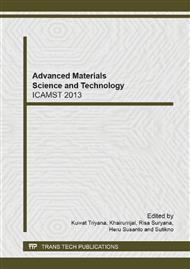p.613
p.617
p.621
p.626
p.633
p.638
p.642
p.646
p.650
Determination of Band Gap Energy of Semiconductor in Homojunction Structure Devices by Using Customized Microcontroller Based Apparatus
Abstract:
We have successfully developed a customized apparatus based on microcontroller for simple band gap energy (Eg) measurement of semiconductors in homojunction structure devices. The apparatus consisted of a data acquisition system based on microcontroller AVR ATMega 128 and a thermos flask equipped with temperature controller. It permits recording of current-voltage (I-V) and temperature and subsequently sends data to a computer to enable the computer processing of such data. For samples under tested, we used two types of commercial diode, i.e. Silicon (1N4007) and Germanium (1N60). In this measurement, the voltage across the resistor was used to calculate the current while the voltage across the diode gave the forward bias voltage. The temperature of diode was varied from 5°C to 80°C. During each I-V measurement, the temperature of diode was maintained to be constant by employing a proportional-integral-derivative (PID) controller to the heater. Furthermore, by varying the temperature of diode, we could extract the saturation currents under reverse bias across the diode of each I-V measurement. For the two types of diode, it is found that the Eg of silicon is 1.13 ± 0.03 eV, while that of germanium is 0.71 ± 0.03 eV. This result is closed to the Eg value of each diode indicated in the respective datasheet. Therefore, it suggests for applying this apparatus for measuring Eg of semiconductor in most homojunction structure devices.
Info:
Periodical:
Pages:
633-637
Citation:
Online since:
February 2014
Keywords:
Price:
Сopyright:
© 2014 Trans Tech Publications Ltd. All Rights Reserved
Share:
Citation:


